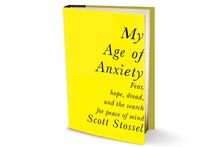My Age of Anxiety
By Scott Stossel
416 pages;
Knopf
The backstory on sweating the small stuff.
By some estimates, more than 25 percent of Americans can expect to suffer from clinically diagnosed anxiety, which is why My Age of Anxiety: Fear, Hope, Dread, and the Search for Peace of Mind, Scott Stossel's erudite, heartfelt and occasionally darkly funny meld of memoir, cultural history and science, feels excruciatingly relevant. Stossel aims to better understand his own stressed-out state of mind while also tracing the condition's history from Hippocrates (who saw it primarily as medical in nature) to Freud (who viewed it as psychological, with its roots in sexual inhibition) to modern times.
Whether in its most severe form, as in the author's crippling version that is "woven into my soul and hardwired into my body and...makes my life a misery," or in the less debilitating manifestation many of us have known from time to time, anxiety is now an omnipresent, extensively medicated syndrome that may be a result of a brain malfunction or a product of our environment—no one knows for sure. But Stossel's harrowing account of his own experience with phobias—among them claustrophobia, acrophobia (fear of heights), asthenophobia (fear of fainting), bacillophobia (fear of germs) and aerophobia (fear of flying)—strongly suggests that this is a disease without a cure.
Stossel, the editor of The Atlantic, is a wry, if distressed, chronicler of his own history and that of psychopharmacology. It's been a long and in many ways frightening journey for him. Still, near the end of the book, in a chapter titled "Redemption," Stossel attempts to see the upside of anxiety—the links between it and creativity, productivity, morality. His therapist advises him to give himself more credit for being resilient, and it seems he does. He concludes with the hope that "admitting my shame and fear to the world" will ultimately be "empowering and anxiety reducing."
We hope so, too.
— Amy Bloom


